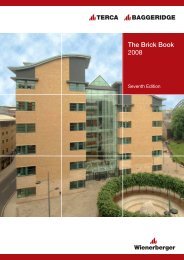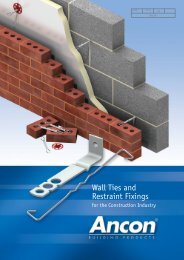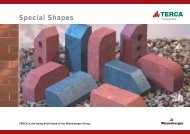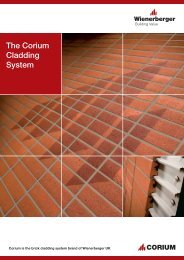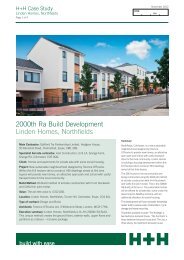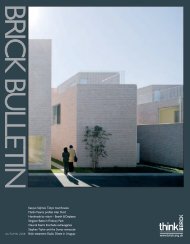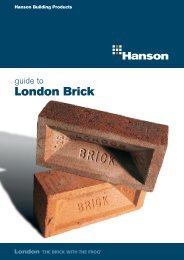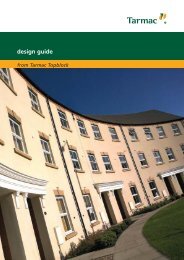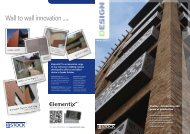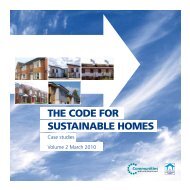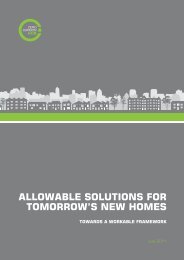Thermal Performance: Part L1A - Masonryfirst.com
Thermal Performance: Part L1A - Masonryfirst.com
Thermal Performance: Part L1A - Masonryfirst.com
Create successful ePaper yourself
Turn your PDF publications into a flip-book with our unique Google optimized e-Paper software.
<strong>Thermal</strong> <strong>Performance</strong>: <strong>Part</strong> <strong>L1A</strong>Key conclusionsThe <strong>Part</strong> L challengeFor current and future editions of <strong>Part</strong> L, the challenges for differenthouse types are the same for all materials. With regard to concrete andmasonry, existing materials and systems can readily achieve <strong>com</strong>pliancewith the FEES and proposed carbon <strong>com</strong>pliance standard, which all newdwellings must meet from 2016.Cavity wallsA partial fill cavity wall can achieve a U-value down to 0.15 W/m 2 Kwith a 150mm cavity or 0.18 W/m 2 K with a 130mm cavity, which isappropriate for <strong>Part</strong> L 2016 and the FEES. In the case of full fill insulation,U-values of 0.17-0.18 W/m 2 K can now be achieved with a cavity of only100mm using proprietary insulation systems [2]. With these levels ofperformance, cavity wall thickness is unlikely to increase appreciably inresponse to future changes to <strong>Part</strong> L and the introduction of the FEES.No single approachA single design approach to minimising CO 2 emissions will not suit allhouse types. For example, houses with a large external area benefit mostfrom improved fabric performance, whilst smaller attached units benefitmore from enhancements to the services and use of renewables.Heat recovery systemsOne of the benefits of heat recovery systems is their ability to provide anintermediate step between optimising fabric energy efficiency and theuse of renewables to meet 2010 and 2013 <strong>Part</strong> L requirements.Compliance with <strong>Part</strong> L: 2010While <strong>com</strong>pliance can be achieved without the use of renewables,depending on dwelling type, enhancements to the services maybe necessary.Compliance with <strong>Part</strong> L: 2013Compliance can be achieved without renewables, providing there is asufficiently high standard of fabric performance and the services areupgraded e.g. with one or more heat recovery systems (see Figure 3).Alternatively, a more relaxed fabric specification can be used inconjunction with a renewable technology such as photovoltaics (PV);although this may be a more expensive route to <strong>com</strong>pliance.Compliance with <strong>Part</strong> L: 2016<strong>Performance</strong> requirements for 2016 are still to be finalised, but initialindications are that <strong>com</strong>pliance can be achieved in a variety of waysusing the FEES fabric specification (or better), in <strong>com</strong>bination with oneor more heat recovery systems and/or PV. The extent to which thesetechnologies are needed depends very much on the dwelling type andlevel of fabric performance adopted.Figure 1: Advances in insulation make U-values as low as 0.17 possible in astandard 100mm cavity wall. Courtesy of Xtratherm Ltd.<strong>Part</strong>y walls<strong>Part</strong> L now requires fully filling and/or edge sealing of cavity party wallsto reduce heat loss. Robust Details Ltd has published a range of new fullfill party wall solutions for masonry construction.<strong>Thermal</strong> bridgingThe current 2006 Accredited Construction Details (ACDs) typicallyprovide an equivalent y-value of about 0.05 - 0.06 W/m 2 K for concreteand masonry housing, which is suitable for 2010 <strong>Part</strong> L <strong>com</strong>pliance.Enhanced construction details are also available for concrete andmasonry, which offer equivalent y-values in the range of 0.03 - 0.04 W/m 2 K, appropriate for the highest levels of performance.Air leakageAn air permeability rate of around 5m 3 /(h.m 2 ) is now fairly standard, withlower values achievable when required. In fact, results from pressuretesting over the last few years shows that, of the housing which achievedan air permeability of 3m 3 /(h.m 2 ) or better, the highest proportion wereof masonry construction with a wet plaster finish [3].Brookwood Farm, Woking, Surrey. Code Level 5 housing, built using insulatingconcrete formwork.3



